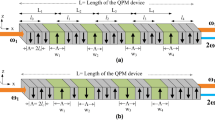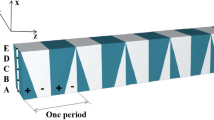Abstract
We have analyzed the role of phase shifter domains in QPM devices for domain engineering. These phase shifter domains are capable of changing the phase of the second harmonics from 0 to 2π. Using this approach, we have generated multiple second harmonic peaks by introducing phase shifter domains of same width at unequal intervals in the periodic optical superlattice structure. Furthermore, we have theoretically analyzed the generation of multiple-QPM and the possibilities to engineer the intensity and bandwidth of the multiple peaks.
Access provided by CONRICYT-eBooks. Download conference paper PDF
Similar content being viewed by others
1 Introduction
Quasi-phase matching (QPM) technique allows efficient generation of higher harmonics by varying the polarization of a nonlinear crystal [1]. In this technique, the nonlinear optical coefficient (d eff ) within the nonlinear crystal is periodically reversed to 180° relative to the neighbour about the axis of propagation to form a grating of period Λ = 2l c , where, l c is the coherence length [2]. This kind of QPM grating structures could be easily fabricated by room temperature electric field poling method. In addition, various engineered domain structures have been proposed to achieve multiple-QPM, which includes a grating with sinusoidal modulation, phase reversal, aperiodic optical superlattice structure, continuously phase modulated superlattice structure and quasi-periodic optical superlattice structure [3]. We introduce phase shifter domains in periodic QPM device to generate multiple peaks for optical frequency conversion process [4, 5]. QPM device is useful in the current optical communication system in which the incoming optical-fiber signal is directly converted into the other channel without electrical processing in fiber based wavelength division multiplexed (WDM) systems. So, our proposed QPM design can generate desirable multiple peaks with tunable spacing, bandwidth, and intensity which could be useful to employ the same in WDM systems.
2 Theory
The coupled wave equation for basic slowly varying amplitude resulting to the growth of second harmonic generation which is obtained from Maxwell equations is given as [2],
where, A1(2), is the electric field amplitude of the second-harmonic wave, κ is proportional to the effective nonlinear optical coefficient and the wave-vector mismatch. The wave vector-mismatch for the QPM interaction Δk is given as,
where, G is the grating vector factor. With the assumption of negligible depletion of the fundamental wave, the amplitude of the second harmonic wave can be calculated by integrating the (1) to obtain a sinc form of the spectrum, κ is constant in the medium. But, κ is not constant. It is a function of z, i.e., κ(z). Let Δκ = 2πq, then the second harmonic amplitude can be expressed as,
3 Results and Discussion
We have analyzed the second harmonic spectrum of periodic QPM device as depicted in Fig. 1a. Moreover, we introduce phase shifter domains in the periodic structure to generate multiple peaks. This phase shifter domains can vary the phase of second harmonics from 0 to 2π.
In this approach, we have distributed three phase-shifter domains of same width at unequal intervals in the periodic structure. This concept has generated four equally spaced second harmonic peaks of different intensities as shown in Fig. 1b. Similarly, we have distributed more numbers of phase shifter domains such as n = (five, seven, nine etc.,) of same width at unequal intervals in a periodic QPM device. We could observed n + 1 numbers of second harmonic peaks which is a function of phase-shifter domains. Moreover, from our theoretical analysis we observed that the peak intensity is also a function of width and location of the phase shifter domains in the QPM device. Further works are going on to engineer the number of peaks, spacing and intensity of the second harmonic peaks to utilize in WDM systems.
4 Conclusion
Multiple SH peaks have been generated by introducing phase-shifter domains of same width at unequal position in the periodic QPM device. The proposed QPM device with phase shifter domains of same widths is capable of tailoring the intensity, spacing and number of SH peaks.
References
D. S. Hum, and M. M. Fejer, “Quasi-phasematching,” C. R. Physique 2, 180–198 (2007).
M. M. Fejer, G. A. Magel, D. H. Jundt, and R. L. Byer, “Quasi-Phase-Matched Second Harmonic Generation: Tuning and Tolerances,” IEEE J. Quantum Electron. 28 (11), 2631–2654 (1992).
M. Asobe, O. Tadanaga, H. Miyazawa, Y. Nishida and H. Suzuki, “Multiple Quasi-Phase-Matched Device using Continuous Phase Modulation of χ(2) Grating and Its Application to Variable Wavelength Conversion,” IEEE J. Quantum Electron 41 (12), 1540–1547 (2005).
S. Hari Hara Subramani, K. Karthikeyan, A. Mirunalini, R.K. Prasath, S. Boomadevi, and K. Pandiyan, “Analysis of a phase reversal quasi-phase matching device for the dual peak second harmonic response,” Journal of Optics (IOP) 15(5), 055205–055210 (2013).
T. S. Meetei, S. Hari Hara Subramani, S. Boomadevi, K. Pandiyan, “Advances in Optical and Engineering,” Springer Proceeding in Physics, 166, 461–463 (2015).
Acknowledgements
The authors wish to express their sincere gratitude to the Department of Science & Technology (DST), New Delhi, India for their financial support (Ref. No.: SB/FTP/PS-089/2013).
Author information
Authors and Affiliations
Corresponding author
Editor information
Editors and Affiliations
Rights and permissions
Copyright information
© 2017 Springer Nature Singapore Pte Ltd.
About this paper
Cite this paper
Asvin, N., Ganesh, A., Raj, N.I., Meetei, T.S., Boomadevi, S., Pandiyan, K. (2017). Phase Shifters in QPM Device for Domain Engineering. In: Bhattacharya, I., Chakrabarti, S., Reehal, H., Lakshminarayanan, V. (eds) Advances in Optical Science and Engineering. Springer Proceedings in Physics, vol 194. Springer, Singapore. https://doi.org/10.1007/978-981-10-3908-9_64
Download citation
DOI: https://doi.org/10.1007/978-981-10-3908-9_64
Published:
Publisher Name: Springer, Singapore
Print ISBN: 978-981-10-3907-2
Online ISBN: 978-981-10-3908-9
eBook Packages: Physics and AstronomyPhysics and Astronomy (R0)





